Neutron-scattering study of metallic sodium.
H.Abe, K.Ohshima, T.Suzuki and S.Hoshino
Institute of Applied Physics, University of Tsukuba, Tukuba 305, Japan
K.Kakurai
Institute for Solid State Physics, University of Tokyo, Roppongi, Minatoku,
Tokyo 106, Japan
Phys.Rev.B, Vol.49, pp3739-3745(1994).
A neutron elastic- and inelastic-scattering study has been
performed on single crystals of metallic sodium over a temperature range
of 10 to 300 K. On cooling the virgin sample, the incubation time to transform
from the bcc structure to the low-temperature structure was found to be
more than 2 h at 38 K. The full width at half maximum (FWHM) of the (110)bcc
Bragg reflection suddenly increased from 0.3 to 0.73 degrees, due to some
deformation introduced by the nucleation of the low-temperature structure.
In relation to the deformation, stron extra-diffuse scattering was observed
around the (110)bcc Bragg reflection in addition to thermal
diffuse scattering. On warming though the transformation, the FWHM gradually
recovered but was larger than that of the virgin state. Apparently some
deformation still remained in the bcc structure even though the low-temperature
structure disappeared. It was estimated that the cluster size of the low-temperature
phase is more than 3.2 nm along the c axis from analzing the Huang-type
diffuse scattering. On cooling again, the phase transition did not take
place untill 10 K and a waiting time of at least 20min at that temperature
was needed before the transformation took place. No drastic change in the
TA1[110] phonon-dispersion branch downto 38 K was observed,
though the phonon energies for q > 0.25 decreased slightly with decreasing
temperature.
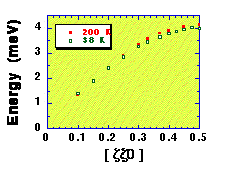 |
FIG.1
Phonon-dispersion curve of the TA1[110] branch at 200K () and
38K(). |
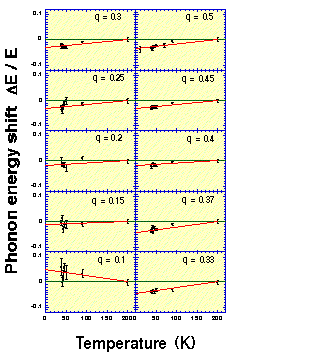 |
FIG.2
Relative phonon energy shifts DeltaE/E vs temperature for phonons of the
TA1[110] branch. |
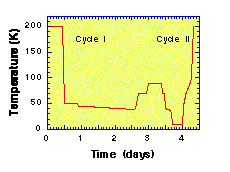 |
FIG.3
Schematic drawing of the temperature cycle. |
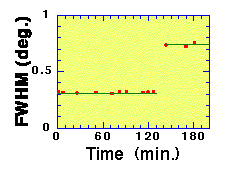 |
FIG.4
FWHM of the (110)bcc Bragg reflection vs time at 38 K. |
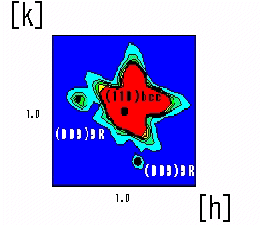 |
FIG.5
Equi-intensity distribution in the (hk0) reciprocal-lattice plane including
(110)bcc and (009)9R Bragg reflections. |
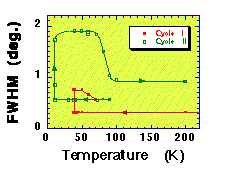 |
FIG.6
Temperature dependence of FWHM for the (110)bcc Bragg reflection.
() First temperature cycle (200->38->90 K) and () second temperature
cycle(90->10->200K). |
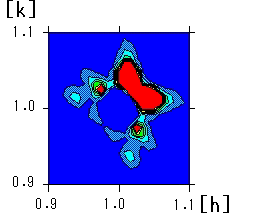 |
FIG.9
Intensity distribution of Huang-type diffuse scattering IHDS
at 38 K on (hk0) plane. Central circle means two-dimensional distribution
at half maximum of the intensity for the (110)bcc Bragg reflection.
The line is shown for reference in Fig.10. |
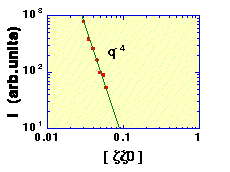 |
FIG.10
Intensity IHDS vs reduced wave vactor z=qa0/sqrt(2)pi
at (110)bcc along the [110] direction, where a0 is
the lattice parameter of the bcc structure. The line measured is depicted
in Fig.9. |
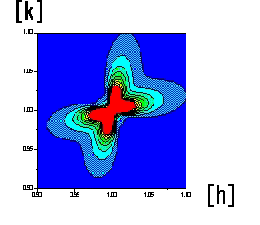 |
FIG.11
Intensity distribution calculated by Eq.(1) in the text on the (hk0) plane.
Compare it with Fig.9. |
REFERENCES
1) C. S. Barret, Acta Crystallogr. 9, 671(1956).
2) R. Berliner, O. Fajen, H. G. Smith and R. L. Hitterman, Phys. Rev.
B40, 12086(1989).
3) O. Blaschko and G. Krexner, Phys. Rev. B30, 1667 (1984).
4) V. G. Vaks, M. I. Katsnelson, V. G. Koreshkov, A. I. Likhtenstein,
O. E. Parfenov, V. F. Skok, V. A. Suhhoparov, A. V. Trefilov and A. A.
Chernyshov, J. Phys. Condens. Matter 1, 5319 (1989).
5) R. Berliner, H. G. Smith, J. R. D. Copley and J. Trivisonno, Phys.
Rev. B46, 14436 (1992).
6) W. Schwarz, O. Blaschko and I. Gorgas, Phys. Rev. B46, 14448
(1992).
7) G. Ernst, C. Artner, O. Blaschko and G. Krexner, Phys. Rev. B33,
6465 (1986).
8) H. G. Smith, Phys. Rev. Lett. 58, 1228 (1987).
9) R. J. Gooding and J. A. Krumhansl, Phys. Rev. B38, 1695 (1988).
10) H. G. Smith, R. Berliner, J. D. Jorgensen, M. Nielsen and J. Trivisonno,
Phys. Rev. B41, 1231 (1990).
11) W. Schwarz, O. Blaschko and I. Gorgas, Phys. Rev. B44, 6785
(1991).
12) L. Pintschovius, O. Blaschko, G. Krexner, M. de Podesta and R. Currat,
Phys. Rev. B35, 9330 (1987).
13) H. You, J. D. Axe, D. Hohlwein and J. B. Hastings, Phys. Rev. B35,
9333 (1987).
14) P. H. Dederichs, J. Phys. F3, 471 (1973).
15) B. E. Warren, X-ray Diffraction (Addison-Wesley, Reading, MA, 1969).
 Back
to Publications List
Back
to Publications List
ab@cc.nda.ac.jp
Department of Materials Science and Engineering
National Defense Academy
Last Modified: April 1, 2009








